How often have you thought about starting a freelance writing business but had no idea where to start?
You dream of not setting an alarm clock, working on your own terms (and in your own time), whilst earning enough money to support yourself and your family.
But every time you sit down to start you’re met with the crushing feeling of, “I have no idea what I’m doing!”
Sound about right so far?
Well, if you’re anything like I was when I first started out as a freelance writer, that’s exactly what you’re going through.
But don’t fret.
In this guide I’m going to show you exactly what you need to do to get your freelance writing business off the ground and start building momentum. So let’s get started!
Here’s What We’re Covering:
- Deal With Your Fear Of Freelancing
- Finding Your Perfect Niche
- Get Your First Portfolio Pieces And Stand Out From The Crowd
- Identify The Right Places To Look
- Writing Pitches That Stand Out
- Structure Your Business Model
- Wrapping This Up…
Do you think you can benefit from these topics? Well, let’s get started then!
Step #1: Deal With The Fear of Freelance Writing
When you first start out freelancing there’s always a level of doubt involved. You’ll often find yourself thinking thoughts like:
- “I’m scared my writing isn’t good enough”
- “I may be biting off more than I can chew”
- “A client might invest money into me and I’m scared I can’t deliver the work”
These thoughts hit home because they seem so real and rational, don’t they?
But the truth is they’re just your mind throwing up reasons not do so something scary. To not put yourself outside of your comfort zone and take a risk.
The best way I’ve found for freelance writers to deal with this is to start to take action. Once you’re moving and you’ve got momentum the fear isn’t there anymore.
Write pitches, brainstorm content ideas, connect with people and just do the thing you’re scared of. (It’s usually a sign you’re moving in the right direction).
If you screw it up, you can dust yourself off and carry on. If you don’t screw it up, then you’ve just made a client and lined your back pocket.
In the immortal words of the singer and rapper Travie McCoy, “Take a step back, and a breath in, let out now, put your chin up, you can do it Tiger you a (wo)man now, and in your dreams it’s time to do the best you can now.”
Handpicked Content for You: What’s the right business model?
Step #2: Finding Your Perfect Niche
One of the most important steps you can ever take as a freelance writer is to niche down your business.
It’s a scary concept because you want to be able to appeal to everyone. After all, the more types of clients you can attract, the more money you can make, right?
Well the truth is that by not picking a niche you make it much harder to make money in the long run. Because whilst you may be able to get an OK rate – $30 to $40 an hour – as a jack of all trades, you’re giving up the $80, $100 and $300 an hour contracts further down the line.
You Make Significantly More Money Picking a Niche
For example I started as a freelance writer in the Internet Marketing niche making $30 an hour writing for blogs. The more I learned about the subject, the more impressive my client base, and the higher of standard of writing I achieved allowed me to command more money.
By the time I stopped writing in that niche in June 2017 I was able to charge up to $1,100 per article.
This also allows you to develop a presence within that niche. The people you work for often have other friends within the niche, and the chance of getting referral work increase:
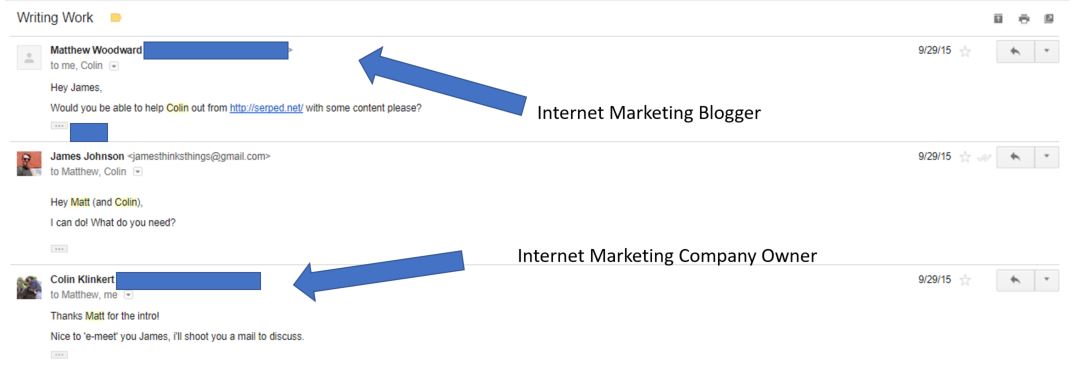
These types of lucrative referrals are harder to come by if you stay at the lower levels of freelancing and bounce around between niches.
Glenn Allsopp of Viper Chill and Gaps noticed the same when he was first starting out. He was happy to take any old SEO contract that came his way. And, found himself not making much money because of it.
However when saw the success of niched down businesses – working in specific industries, or for specific client needs – and adopted the same strategy, he went on to generate six figures and eventually millions per year.
The beauty of being a freelancer is also that you don’t have to choose just one niche if you don’t want to. You can become well known in two or three niches without burning yourself out and catering to specific client needs. After all, human beings tend to have varied interests.
In the rest of this section you’ll explore the different kinds of niches you can work in, and how to find the niches that will be most profitable (and interesting) for you…
Interest Niches: The Niches You Love to Work In
Interest niches are the areas of your life you’d spend time on even if you weren’t getting paid.
This is hobbies, topics you like to read about, the email lists you subscribe to and the activities that make you feel good.
These are the perfect niches to have clients in because it feels less like work. You’re immersed in a topic you love and are constantly learning about it.
Let’s say you’re really into cooking.
By selecting cooking as one of your interest niches you could open yourself up to a world of opportunities in all facets of that niche.
You could write:
- Content for food and cookery blogs
- Scripts for food related podcasts
- Scripts and content for Vloggers and YouTubers
- Whitepapers or content marketing pieces for kitchenware companies
- Food trucks and indie restaurants menus
That’s just what I’ve been able to come up with off the top of my head. Think about what you can do if you’re even more immersed in the niche.
Trouble Choosing an Interesting Niche
One problem I often come across here, though, is that you’re not quite sure what it is that you’re interested in. It sounds absurd, by as soon as someone asks you to think about it, your mind goes blank.
Don’t worry though, there’s a solution for that…
The advice I give to my students here is to follow two things: your money and your time.
If you’re spending time and money in a specific niche, it means there is also money to be made there. And you can do this quite simply.
Head over to Amazon (or your bank account) and look at your purchases for the last six months:

Here you’ll find a list of everything you’ve bought through the site, and find a great indication of the niches you’re interested in.
Sometimes it may feel as though what you’re looking at doesn’t give you much in the way of clues. For example, my recent purchases are all just books for the Kindle:
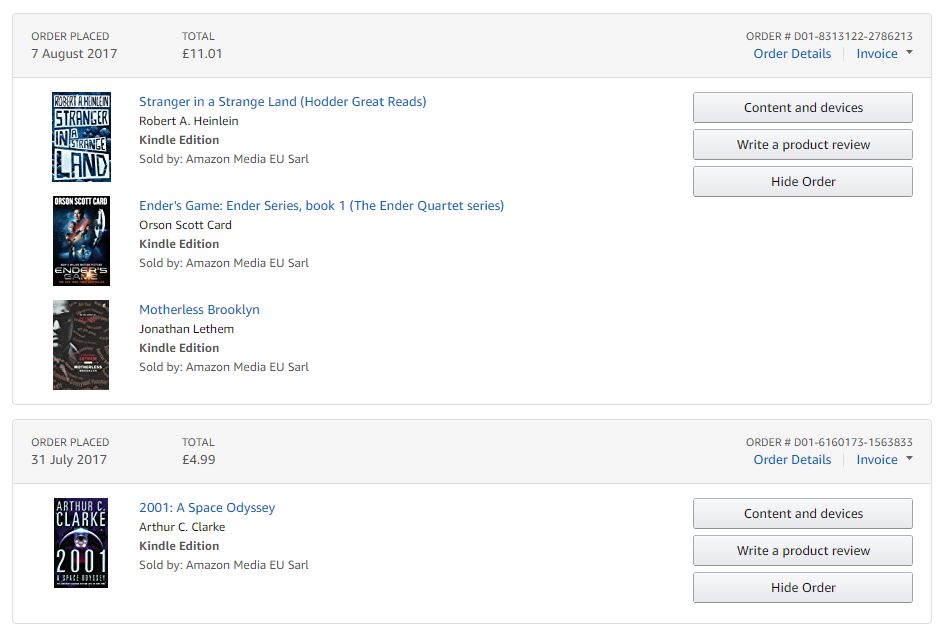
However when I give it a closer look there are some clues. These books were all bought because of a Tim Ferriss article I read that recommended them.
Why was I on his site?
Because I’m interested in learning about business growth and health and fitness. And all of the non-fiction books of my shelves draw me to the same conclusion.
It may seem like a long leap but the connection is there. Don’t be afraid to drill down and ask yourself, why?
Skill Niches: The Niches You’re Good At
There are parts of your life where you’re above average compared to the people around you.
It’s somewhere you have a level of knowledge, expertise or experience that you could confidently write about.
If you’re unsure about what this is you can as a couple of friends a simple question:
“Do I have any skills, or do anything in particular where I really stand out?”
Their answers could really be anything: editing YouTube videos, hanging shelves, stitching buttons or setting up social media accounts. Often it’ll be something that you don’t even think is a skill.
Honing in on these niches is a great way to help you find your starter niche, where your knowledge outweighs your experience.
For example, my first ever freelance contract – $250 to create a strength training eBook through UpWork- came about because I used to be a personal trainer and had on-the-job experience writing strength training programs. (The fact I’d been out of the industry for two years didn’t matter).
Style Niches: The Type of Work You Want to Do
A style niche is the style of work that you want to do; think of it as a niche within a profession.
The freelance photographer who only works at weddings has chosen a style niche. So has the freelance music producer who only works on Techno.
Your style niche tends to be born from the direction you’re pulled in as a creator or a worker. If you find yourself drawn to a particular area of your craft, that’s your style niche right there.
This can be the scariest type of niche of all because you really pick a small lane and stay with it. But it can also be immensely profitable at the other end.
It’s Important To Be Realistic…
I’m going to be straight up:
Not all of your niches will be profitable. Sometimes you’ll have an interest where it’s just not viable to make money as a freelance writer. The pay will be too low, or the demand, or it’ll be flooded with writers pitching themselves at $9 for 1000 words.
So it’s important to test your niches and do your research to see what you can find. Think:
- How many actives blog are there is this niche?
- Are there lots of companies creating products for this niche?
- Can you find Facebook groups and forums in this niche?
- Are there YouTubers and Podcasters making a living from it?
- Could you walk down to your local supermarket and pick up a handful of magazines on the topic?
Perhaps you’ll have to make a compromise. You may only be able to make money in one area of your niche. Are you okay doing that kind of work? If not, find another one you’re more willing to work in.
I believe there is money to be made in most niches. But it’s worth finding out before you commit to a niche, not after you’ve spent 10 weeks pitching.
Freelance Action Step # 1
In this step you’re going to narrow down the niches that you want to work in. Using the information above do some research to find three niches that you’d like to work in. You can use a mix of all three, or pull all of them from one area. Just wherever you feel comfortable.
If you’re stuck remember you can:
- Look through your recent purchases and interests to find the niches that you’re interested in
- Break down each of your interests into a new area (where people spend or make money)
- Ask yourself which of your skills would someone need from you in a crisis?
- Drill down to find the parts of your work or art that you’re drawn to as a style
You’ll found out where this list really comes into play when you get down to the business model section of this guide. But, for now, keep it visible and accessible.
Step #3: Get Your First Freelance Writing Portfolio Pieces
It often seems that in order to get hired as a freelancer you have to have experience, but in order to have experience, you have to get hired. How are you even supposed to compete with that?
It’s the soul destroying loop of the new freelance writer.
You pitch and you pitch and you pitch and you hope to god that someone (anyone!) will hire you and finally break the loop for you.
It doesn’t have to be that way, though.
You are able to break that loop for yourself. All you need is a little elbow grease, time and the willingness to do some free work.
You see, freelancers like you and me tend to fret about getting that first paid gig to use a portfolio piece. But that misses the point. (Nobody has ever asked me for proof of an invoice before).
What a potential client is really looking for is that someone has endorsed your work. They just don’t want to be the first person to take a chance on you.
In other words, they want social proof.
So if you can get someone to endorse your work – by way of a guest blog post writing the copy for their site, putting together a short eBook – you’ll be able to give them social proof. No money has to trade hands at all.
Check out this list of 1500 Quality Blog Sites That Accept Guest Posts.
In this section we’ll explore where you can get some free work under your belt to use as portfolio pieces, and finally break that soul destroying loop.
(Quick Note: All of the ideas in the next stages should, ideally, tie into the list of niches that you came up with earlier. Try to stay as true to that list as possible).
Guest Posting On Industry Sites (Pitch and Searches Included)
Guest Posting has been the most effective way I’ve found for freelance writers to start their businesses.
It comes with all of the benefits of social proof, it promotes your business to hundreds (hopefully thousands) of people, and it helps you cement an authority place in your niche.
For example, when I wrote this guest post over on Buffer, I was approached by the owner of a content marketing company to write for his site just days after:

Getting featured on these blogs can be a pretty scary thought. After all, right now, you’re an unproven writer looking to get hired.
But the truth is that getting featured on high quality blogs in your chosen niche isn’t as hard as you’d think. Why?
Because lots of these blogs live and die on the content that their users and writers create. They aren’t focused solely on quality – they need a hell of a lot of quantity too. That’s where you’re going to come in and help them out.
Using the search terms below head to Google and look for blogs that are actively searching for writers:
- [Your niche] + “Write for us”
- [Your niche] + “Submit post”
- [Your niche] + “Contributor guidelines”
- [Your niche] + “Submit article”
This should bring up a list of results like the one below:
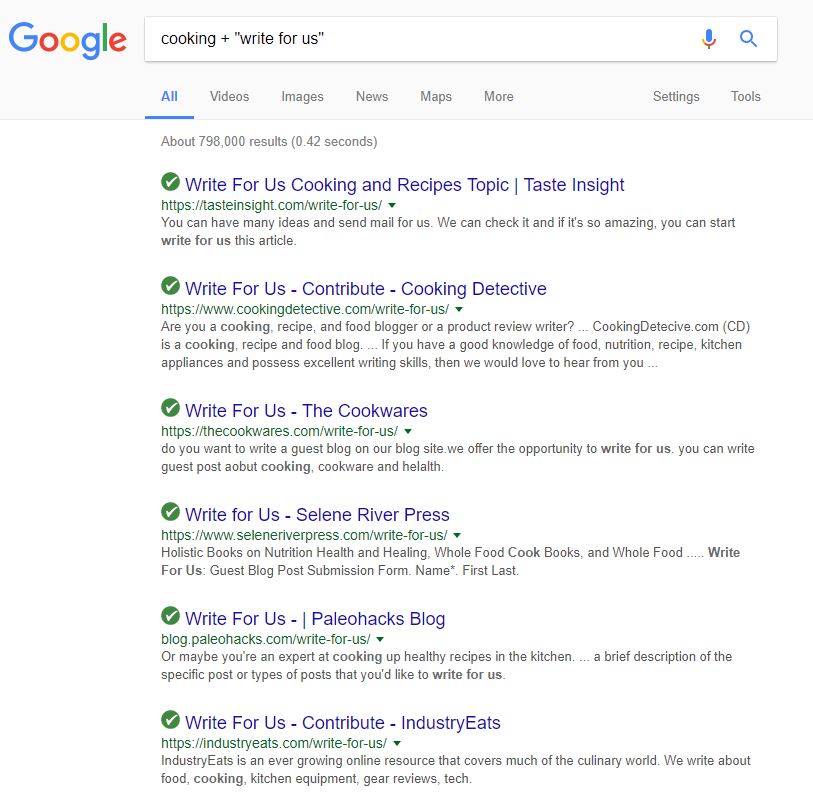
You can then either create bookmarks, or spreadsheets, out of the links you find to keep them in a safe place.
Take some time to familiarise yourself with their contributor guidelines, read the comments on their blog and explore their social media channels to see what content would be a good fit for them.
Ideally you want to go in and pitch them with two to three ideas of content for them to choose from, based on what you’ve read.
You can then reach out to them with this pitch:
Guest Posting Pitch Script
“Hey [Name],
I know you must be buried in email so I’ll keep this snappy…
My name is [your name] and I’m a writer and avid [relevant niche] from [your location]. I love reading [their publication] and I recently used [relevant article + link] to help me achieve [positive outcome].
I’ve been paying a lot of attention to the chatter on [social media/comments] and I couldn’t help but notice this comment pop up [include link if possible] about [relevant topic]. It’s quite close to my heart and I’d love to be able to start a great discussion about it with your readers.
I’ve put together [number] ideas of how this could look for you to choose from:
- [Headline] + [one sentence description]
- Headline] + [one sentence description]
- Headline] + [one sentence description]
If you like any of them just let me know the number and I’ll get straight to work on a draft for you. Or, if you’d like any more information about either of them, please feel free to ask for it.
No worries if not, I’ll still be around as a reader and joining in the conversation 🙂
Thanks,
[Your name]”
The Shameless Facebook Ask (Script Included)
Keith Ferrazzi, in his book Never Eat Alone, explains that your network is like a garden.
For every bush and branch and leaf and twig there is a new offshoot that connects to someone else. Your garden is pretty much overgrown with your network, and the networks of the people you know.
One of the best places to tap into those networks is through Facebook. There’s a lot of attention there and someone is almost always willing to tag a friend in your status.
All you’ve got to do is have the confidence to do a shameless ask and tell your friends you’re looking for a little help, or to be put in touch with the right person.
It doesn’t have to be anything fancy, just edit the script below to sound like you:
Facebook Pitch Script
“Hey guys!
As some of you may know I’m working on starting and growing my freelance writing business. And I’m trying to connect with as many people as possible who I might be able to help improve their [DESIRED RESULT YOUR WORK DOES].
If you know anyone who may be interested or needs work from my industry, I’d love if you could put the two of us in touch.
Thanks in advance :)”
This may not get any bites straight away. Don’t worry if it doesn’t. You may find in a few days or weeks someone comes back to you.
(I also didn’t mention you doing work for free in the script. You can add that at your own discretion in your conversation if you need to).
Email Outreach To People You Know
Asking your friends for help isn’t always appealing. But In this situation you’re going to be offering nothing but value in return for a little help that is 99.9% aimed at benefitting them.
Plus, all’s fair in love and freelancing, right?
In your whole network you’ll have a number of people who:
- Run their own business
- Work for a small business
- Have a freelance job
- Have a side hustle that they work around their job
- Keep a personal or semi-professional blog
- Are in a band
- Volunteer for small local causes in their free time
These are all people who can help you land your first portfolio piece. Think of creative ways you can use your words to help them improve their business, and reach out to them.
I’ve purposely left out adding a script to this section because this should be personal between you and your friend. So all I’ll say is be clear and don’t be afraid to ask for help. The worst they can say is no.
Email Local Businesses (Script Included)
Unless you live in the middle of nowhere, just around the corner from a black hole, there will be some local businesses around you that you’ll be able to help.
It doesn’t take much work to find them and figure out ways that you can use your skills to help them out for free. (Ideally these business will be in one of your niches).
For example, I’m into language learning. So what I’d do is I’d pop something like “Language learning schools near me” into Google and see what comes up.
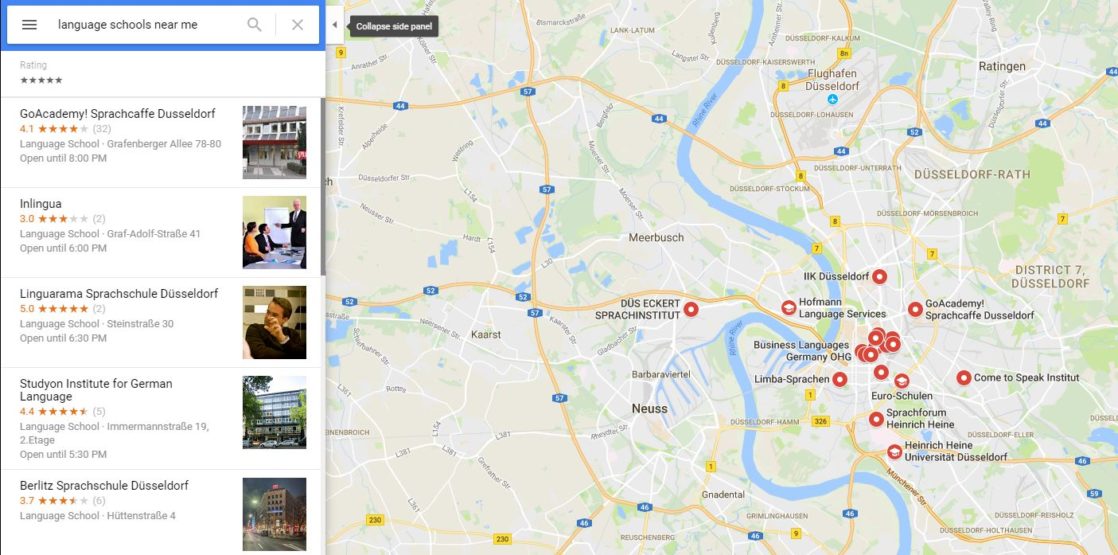
I would then research them and look for ways that I could help them with their business. Then shoot them an email saying how I could help them for free.
If someone has a major event coming up, or is clearly taking a new direction in their business, you can offer to help them with a specific element of that. No doubt your skills can help them, in part, with what they’re trying to do.
For example here’s an email I recently sent to one of my favourite authors offering help for a new book launch:

Although we already have an existing relationship, I’m still willing to exchange my time and skills to help him get to where he wants to go.
But bringing this back to local businesses, here’s a script you can use to reach out to them:
Local Business Outreach Script
“Subject: I’d like to work for you for free… (I have to tip my hat to Ramit Sethi for sharing that)
Hey [Name],
My name is [your name] and I’m a freelance writer from [your local area]. I couldn’t help but notice that you’ve got [event/product/problem] coming soon, and I’d love to help you out (for free) if possible.
I was thinking it might take some pressure off you if I [positive act – like “write a press release”] so that you’re able to [positive result – like “Use it on your homepage to promote your school and future events”].
No catch, I’d just be really interested in helping out a local business.
Thanks and I look forward to hearing from you,
[Your Name].”
Some Other Options To Consider…
Whilst the options above are often the most effective, it never hurts to have a few extra tricks up your sleeve, does it?:
- Competitions: Are there any blogs, magazines or industry sites that are running a competition? You could create an entry and, when it gets used (or makes it to a particular round) you have a strong endorsement there.
- LinkedIn: Could you join any groups on LinkedIn and find people who may need your services? From start-ups to authors to vloggers and consultants. There’s a wide range of people you can find who might need your free help.
- Your local communities: I have a friend, Scott, who started his entire design agency helping people in his church group create websites. The first ones were for free, then he started charging when they referred a friend. That church group business is now a full agency with six employees.
You’re going to be offering enough value here to get a few portfolio pieces under your belt in no time at all. Don’t worry if you don’t get any traction at the beginning, though. It may take a few attempts. (More on that later).
Freelance Action Steps #2
In this action step it’s time to take some strides towards getting your first portfolio piece.
Before moving onto the next section you should try and do one of the three options above. Only one, let’s take it baby steps here. Here’s what I’d suggest:
- Write and publish the Facebook status
- Email one friend you know and ask if you can help him professionally
- Identify one business in your local area and send them a quick email offering to help
Step #4: Identify The Right Places To Look
There are two ways you can use this step:
You can wait until you’ve got your first portfolio pieces in place and then begin to apply for jobs
You can use some of your time whilst you’re getting your pieces in place to peruse the jobs that are out there
Either way it pays to know where you can go to apply for your first paying freelancing jobs.
In this section I’ve included all of the major places you can look for your first job.
And, they’re free to use – unless you want a premium membership – so you don’t need to worry about paying to find jobs.
Freelancing Sites To Check Out
These are the go-to sites for all freelancers at the beginning of their careers. You’ll find jobs in abundance here, and as Brennan Dunn says, they’re more geared towards instant gratification and getting you off the mark:
There may also be some potential to use Fiverr Pro, however I tend to recommend writers steer clear of normal Fiverr and the super low cost opportunities.
In Defense Of UpWork and Friends…
I’ve heard authorities in different niches say that it turns you into a crappy [insert job here] and you pick up all the bad habits.
But I honestly think that’s bullshit.
When you’re first starting out as a freelancer it’s a great place to cut your teeth, and learn how to work with clients, in a lower risk environment.
The payment out of the gate isn’t always the best, granted, but it’s a confidence boosted and once you get a few paid positions under your belt – and a bigger portfolio – you’ll soon find yourself as a much more established freelancer.
You also have the buffer of a third-party system tracking your work, payments and giving you somewhere to get help if things turn south. A luxury not provided in the real world.
Heck, I started my entire freelance writing career there back when it was Elance. But i wouldn’t suggest building your whole freelance writing business there
The idea is to get some experience, get some cash, and then trade your way up to a higher level.
I look at this as a pyramid, like the (awfully made) one below:
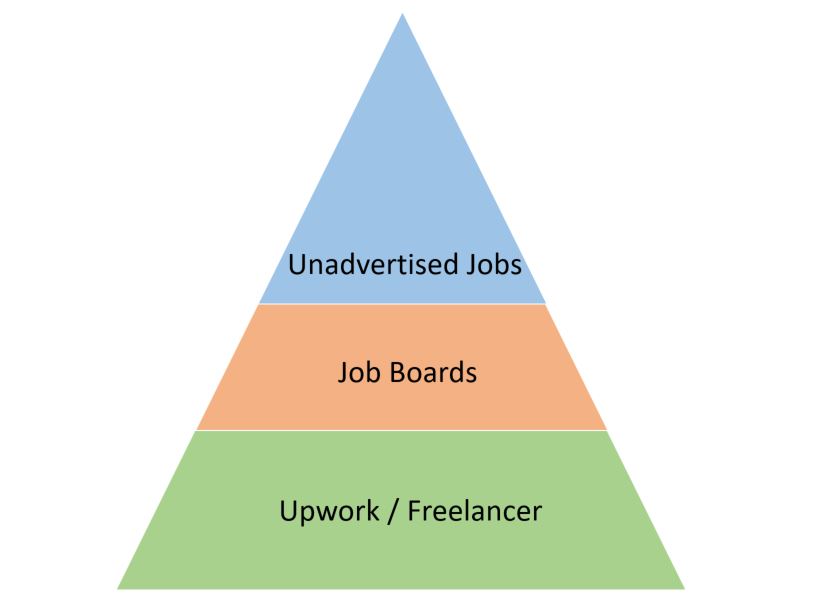
You start off at ground zero and then get everything you need to move up to the middle level. Then, you do the same at the middle level, then trade up to the higher level. And so it goes.
As long as you’re smart enough to say no when a deal doesn’t feel right and not to take jobs that could potentially damage your reputation, there’s nothing wrong with starting here.
Freelance Writing: Job Boards
- ProBlogger Jobs
- All Freelance Writing
- Freelance Writing Jobs
- Blogging Pro
- Morning Coffee Newsletter
- Journalism Jobs
Freelance Action Steps #3
Setting a timer for 60 minutes, take a look around some of these sites and compile any job opportunities that you either find interesting, fit your niche, or that you’d want to apply for.
The main outcome I’m looking for here is that you read and understand the posts that have been made. Sometimes they include information that’s designed to catch you out – and thus filter out non-candidates – so read it with intent.
Step #5: Write Pitches That Stand Out
By now you should have:
- Your niches set out
- Your first portfolio pieces in place
- Read a few job descriptions and got to terms with them
If not, don’t worry, you can still learn a lot from this section. But don’t send any of your pitches until you’ve got the rest in the place.
Your pitch is what makes you stand out from the hundreds of other freelancers vying for someone’s attention. So you need to be able to get your information across to them as clearly as possible and leave a lasting impression.
Now, I have to be honest and admit that everything I learned about freelance writing pitching came from Ludvig Sunström in this StartUp Bros article and their writing guide for entrepreneurs. Although I’ve refined it since then, you’d do well to go and read that article too. But, I digress…
In this section you’re going to learn how to craft a pitch that increase your responses, improves your conversions and shows you as a strong contender for that next freelance job.
The Problem With Your Current Pitch…
Lots of brand new freelance writers make the same mistake.
They’re not sure what to say, and they don’t quite feel comfortable selling themselves just yet, so they write a pitch that is long-winded and never really gets to the point. A little like this one:
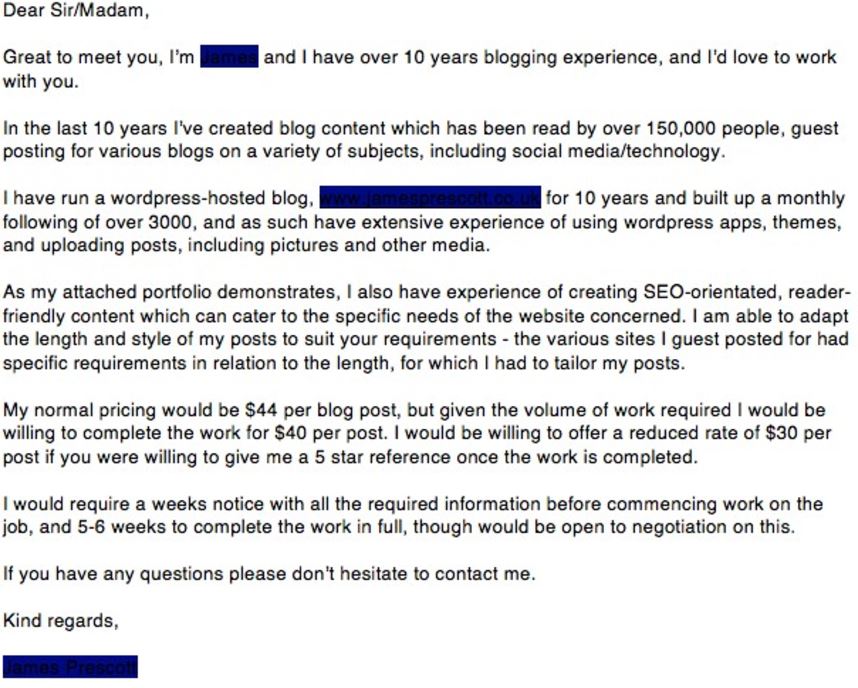
Often, much like this poor soul here, they write a lot of run-on sentences that just list the bare minimum (like creating “reader-friendly content”) that is expected of you.
Also by doing things like:
“Dear Sir/Madam” which would be okay sending a letter to a large corporation, it’s not great when you’re sending an email to someone who LITERALLY has their first name in their email address.
By doing this you’re neglecting:
- Helping me solve the problem that I’m hiring for
- Showing empathy and establishing a connection with me
- Showing me social proof of your work (the endorsement effect back in step three)
All three of which are boxes that need to be ticked to turn me into someone who is interested in you.
There is also a fourth element here, which includes a specific request – like tell me your favorite joke at the end of your pitch – and you miss it , you’re insuring that your email is deleted.
Getting the Pitch Right
In order to get clarity, empathy and show social proof, you’re going to need a punchy, well organized, pitch that packs a punch.
Luckily enough I have just the template for you.
The pitch in the screenshot below has been chopped and changed to fit different potential clients over the years, and it’s helped me land work with big companies, New York Times bestselling authors and seven figure bloggers:
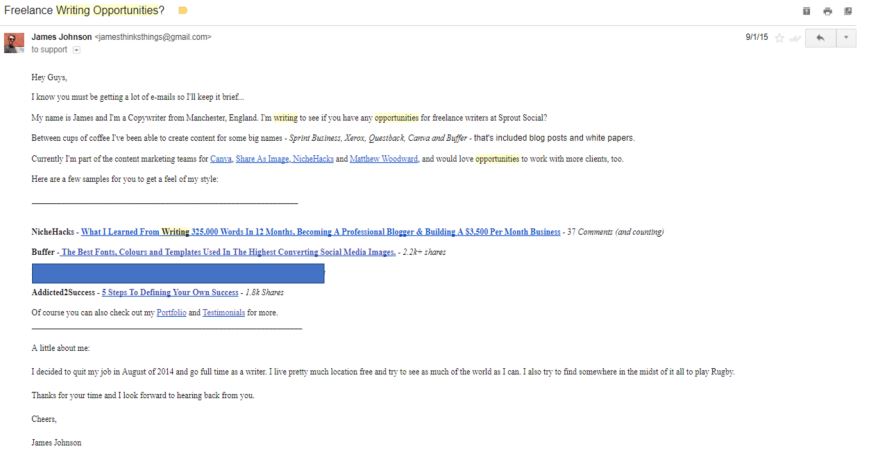
It isn’t the most wow pitch in the world. But man, it does the job.
Below I’ve written the pitch out for you and annotated it so you can see where the different methods come into play:
The Perfectly Detailed Freelance Writing Pitch Script
“My name is James and I’m a Copywriter from Manchester, England. I’m writing to see if you have any opportunities for freelance writers at Sprout Social? [Succinctly explaining who I am, why I’m writing and naming the company directly]
Between cups of coffee I’ve been able to create content for some big names – Sprint Business, Xerox, Questback, Canva and Buffer – that’s included blog posts and white papers. [Providing social proof of who I’ve worked with and what I can do for them if they were to need me]
Currently I’m part of the content marketing teams for Canva, Share As Image, NicheHacks and Matthew Woodward, and would love opportunities to work with more clients, too. [More social proof in the hopes that they know at least one of the clients in my niche]
Here are a few samples for you to get a feel of my style:
________________________________________________________________
NicheHacks
– What I Learned From Writing 325,000 Words In 12 Months, Becoming A Professional Blogger & Building A $3,500 Per Month Business – 37 Comments (and counting)
Buffer
– The Best Fonts, Colours and Templates Used In The Highest Converting Social Media Images. – 2.2k+ shares
Addicted2Success
– 5 Steps To Defining Your Own Success – 1.8k Shares
Of course you can also check out my Portfolio and Testimonials for more.
[This section is REALLY where the magic happens. This is everything they need to know about my business and the results my work has driven into one small snapshot].
_________________________________________________________________
A little about me:
I decided to quit my job in August of 2014 and go full time as a writer. Living pretty much location free and try to see as much of the world as I can. I also try to find somewhere in the midst of it all to play Rugby. [Adding a level of personality. I’m not just a robot who wants their money].
Thanks for your time and I look forward to hearing back from you.
Cheers,
James Johnson”
Can you see the difference between this pitch and the one you looked at in the last section?
There is much less writing here, but much more information. Whether they realise it or not I’m guiding them to help them make a decision every step of the way.
Now I know it’s not the perfect pitch – many people are better at pitching than I am – but it works, and it’s worked for the majority of people I’ve shared it with too.
This also doesn’t just apply to writers, either. It can be used for all types of freelancers, and in the next section I’ll give you a template you can use to create the pitch for yourself.
Your Personalized Freelance Writing Pitch (Template Included)
Regardless of what type of freelancer you are, this pitch will help you stand out in your potential client’s inbox.
You can edit and change everything here to fit you, your style and who you’re writing to. There is annotations for more information.
“Hey [Name], (Ideally address the person by name, but I’ve also used the informal ‘guys’ before when contacting a “[email protected]”)
I know you must [common problem] so I’ll keep this brief…
My name is [Your name] and I’m a freelance [writer/blogger]/copywriter etc.]. I’m writing about [why you’re writing] (For a job board this could be “about your ProBlogger job listing” with a link back to the job, or asking about opportunities).
I’ve been working in [your profession] for [number] years and in that time I’ve had the pleasure of working with [Add social proof] mostly creating work in [Your skill niche].
Right now I’m also working for [relevant examples]… (If you’ve worked for a site or a client they might know, even loosely, try and include a name here. I’ve known it to boost response rates)
If you’d like to get a look at my work I’ve attached a few links below:
_____________________________________________________________
[Example #1] + [Results or Clients Specifications] (This could be any of the examples from your portfolio pieces you acquired before)
[Example #2] + [Results or Clients Specifications]
[Example #3] + [Results or Clients Specifications]
_____________________________________________________________
A little bit about me:
[Two to three sentences of personal bio]
Thanks for your time and I look forward to hearing back from you,
[Your name]”
If You’re Not a Natural Salesperson, Ask Yourself This Question…
Pitching is a scary thing, especially when you’re thinking about rejection. So, I have a simple solution that was once taught to me by a mentor.
Whenever you’re approaching someone ask yourself this question:
How can I help this person?
Once you frame your pitches in this light the usual fears of rejection melt away. Why?
Well because you can help them by:
- Leaving them alone
- Not working with them
- Returning in a few months
- Coming on board as a freelancer
Either way you put yourself in a position of helping that person and giving. Meaning the rejections and the set backs aren’t personal, they’re just another way of helping.
It sounds a bit new age and hippie, but trust me, it works.
Freelance Action Steps #4
In this action step you’re going to take the personalized template and fill it out for yourself. Then, send it to three people who’ll give you an honest opinion about how it reads. Edit and update it based on their feedback and what you feel is right to include. Once that’s in place you’ll be ready to take it to the world.
Step #6: Structure Your Business Model
In his keynote speech at the University of the Arts, Neil Gaiman talked about the freelance world and what it’s like getting jobs. Most notably he says, “People get hired, because, well…somehow they get hired”.
And there is a heck of a lot of truth in that statement. But while luck does play a part in the process, mathematics plays a much bigger part.
You see, freelancing is just a numbers game. You speak (or pitch) to a certain amount of people, you get a certain amount of responses and they lead to a certain amount of clients.
And knowing these numbers can make or break your business.
Once you know your numbers your numbers you know exactly the amount of freelance work you need to put in to get your next client.
This allows you to grow your business and guarantee yourself a freelance income each and every month, because you now have a level of control over your business.
When you don’t know your numbers, every “no” feels like a soul-crushing rejection. But when you know that no is just one step closer to a yes, well…that’s a game changing shift in mentality.
In this section I’m going to show you how to find your numbers and unlock a world of reliable business.
What Do You Mean, My Numbers?
Your numbers are, basically, how many people you’ve:
- Pitched to
- Received a response from
- Converted into a paying customer
Let’s take my friend Jack who is a freelance music producer.
For every ten people that Jack pitches to, he gets four responses. Four responses results in 1 paying opportunity.
That means his numbers look like this:
- 10
- 4
- 1
So if Jack wanted to get four new clients he knows he’d need to pitch to 40 people to get them. This is only ever a rough guide, but the math always seems to work itself out.
As you improve and grow your business you’ll find that your numbers change based on it. You can look out for some red flags too – which I’ll explain later on in this section – that can help you improve too.
So let’s look at how you can do this for yourself…
Setting Up This Freelance Writing Business Model For Yourself
From this moment forward you’re going to track how many pitches you’ve sent in a simple spreadsheet.
This is going to track:
- Where you’ve pitched to
- What weeks you pitched to them
- # of pitches you’ve sent
- Responses you’ve received
- How much income that has lead to (Shout out to Daniel Wallen for this improvement)
This will allow you to input the data as you go and see your results unfold in front of you. (You can download the spreadsheet featured below by clicking here).
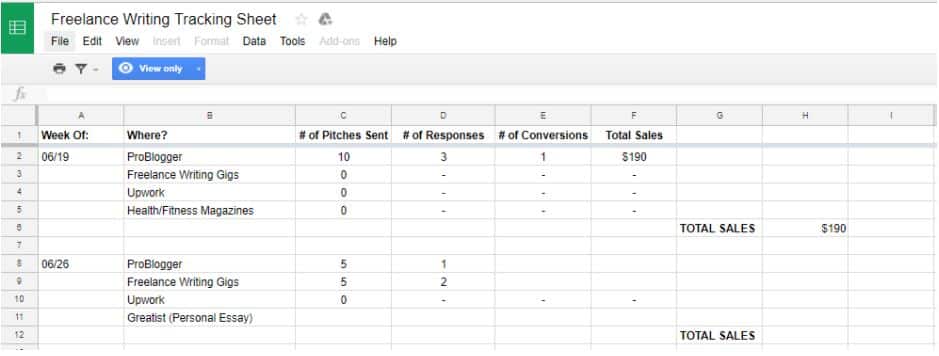
You can group all of the information together and not only see how many pitches you need to be sending, but also where your most profitable streams of income are.
Even today I use a sheet like this at the backbone of my freelance business. Even though I’m terrible at maths, I can follow along and predict and generate more income as I need it.
Lose a client? I know how many pitches I need to improve that.
Need more money? I know how many pitches I need to fix that, too.
This may take a few weeks (or months) to begin to work itself out as predictable. But even with just a general idea you can begin to guarantee yourself and income, and grow it, as you see fit.
Where Your Niche Sheet Fits Into All This…
You may remember earlier in the article I asked you to come up with a sheet of niches that you want to work in.
Well, this is where your list come in and joins with the business model in this section to create a level of order in your business.
Take your niche sheet and rank them from most to least important to you. For me this would be:
- Freelance Writing
- Language Learning
- Budget Travel and Backpacking
Then you’d set your target number of pitches to send for the day. This is ideally your number to get a response (we’ll say 10 for this example).
You would then try to find 10 opportunities in your top ranked niche, either through job boards of cold emailing.
Finding 10 is great because that finishes your day.
If you can only find five though, don’t worry. You can look for the next five in your second niche.
You can then continue to work through your list until you’ve hit your target for the day. Simple, right?
Freelance Action Steps #5
At this stage in the process it’s time for you to go out and start doing your first round of pitches.
You should have everything from the last few steps in place, and be ready to get out into the big world of freelancing.
So, in this action step, you’re going to send your first 10 pitches by the end of the week (or that day, if you’re feeling up to it).
You can then comment on this article to let me know that you’ve done it.
Wrapping This Up…
I hope that after the 6000 words you’ve just read, you feel armed and ready to start your journey as a freelancer.
Whatever you’ve chosen to do, if you follow the steps here and stick to them, you’ll no doubt find yourself with your first clients under your belt in no later than a few months (probably a few weeks).
Now, get out there and start taking action on your dream. So, what are you waiting for?
And, don’t forget to share your stories (and comments and questions) in the comments section below.

Thanks, very helpful article. I believe that you need to be able to quickly understand the topic. Well, if the author worked with what he writes. Or he always has at hand the necessary specialists who will give advice. If not, you will have to quickly and deeply dive the topic yourself. It is also necessary to own different writing styles. For a freelance writer, it is important, on the one hand, to have your own style, and on the other, to be able to adapt to the format required by the customer. It is advisable to be able to write in various formats (instruction, review, analytical article, case, etc.) and optimize texts for modern requirements of search engines. Good luck!
Hello James,
Thanks for sharing the complete guide with tips at one places.
It really is a lot of useful info for newbie freelancers like me who are just starting out freelancer carrer.
Just one question, Can you please recommend site to find freelance writing work except upwork and Contentmart?
Thanks again for all your awesome content!
Hey Saurabh,
Check out https://problogger.com/
It’s one of the best sites out there for writing work.
Hey James,
This article is awesome! Keep up the writing 🙂
thanks, James
Hey James,
Thanks for sharing this impressive guide with tips all at one place.
It will be really helpful for all especially beginners looking out to make a career in freelance writing.
Keep guiding and sharing awesome content.
Gaurav 🙂
Hii James Johnson,
You are great. Your article motivate me, you explained about freelance business in this article.
Thanks.
Hi James
Wow,that is one great piece.It is a full course and most importantly it guides one from fighting the fear,pitching,and where to get the jobs.Im set to begin the journey
Thanks for sharing
Hi James,
This is indeed a complete guide. You almost wrote a full book in just one article.
Freelance writing is something I love so much. While starting out, I didn’t have much issues picking a niche because I hated talking or writing about something I’m not passionate about. So I focused on business writing (B2C).
Though most people think that there’s more money when you are addressing B2B.
Thanks for sharing.
Emenike
Hey James! Thanks for the comment, what are you passionate writing about?